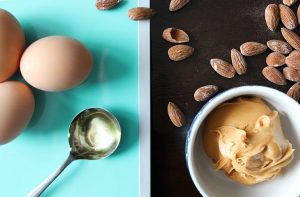Last week’s post promised that we would reveal a weight loss plan that essentially works like gastric bypass surgery–but without the “surgery” part. This is a very doable weight loss program that does not require special foods or medications or even an overnight hospital stay. It is based on fitness expert Chris Powell’s recommendations featured on Dr. Oz’s website. Aside from saving you the cost and risk of a surgical procedure, the best thing about this weight loss plan is that you can customize it to fit your lifestyle. It starts with adding one simple step to your day and includes several little tweaks to enhance your weight loss results. Do them all, or just do the ones that fit comfortably into your schedule.
While it may not bring immediate weight loss, this program does offer fairly fast results that can be maintained. A family member was used as a guinea pig to try this trick out, and he lost 5 pounds in one week by just doing the one basic step. Of course, everyone is different and results will vary depending on the foods you eat and how active you are. Still, even if you could consistently lose a minimum of 4 pounds a month, adding one step to your day is worth it.
The One Thing You Can do to Lose Weight
So, let’s get right to the point: the one simple step Chris Powell recommends that will make your brain think you have had gastric bypass surgery is to eat one measuring tablespoon of dietary fat–specifically almond butter–30 minutes before each meal, and wash it down with a full glass of water. Medical experts explain that this too-easy trick works because the fat will signal the pyloric valve at the end of your stomach to close. It takes about 20 minutes for this process, so that is why the advice is to eat the almond butter 30 minutes before your meal. Between the fat closing off the stomach valve and the water taking up space, your stomach will think that it is already mostly full. You will not be able to overeat, even if you want to. Instead, you will be satisfied to eat much less, just as if you had a gastric bypass.
Why Almond Butter?
There are actually a number of dietary fats you could choose to eat 30 minutes before a meal, but picking one and sticking with it makes this one step as simple as possible. We specifically recommend almond butter over avocados, coconut oil, or other types of nut butters because the flavor and texture are pleasant and because of the additional benefits of almond butter.
We’ve already expounded on the benefits of almonds including their effectiveness at defending from cell-damaging disease such as cancer in addition to reducing your risk of heart disease, Type 2 Diabetes, and Metabolic Syndrome. The vitamins and minerals in almonds boost your immune system, give you energy, and have also shown to increase alertness and improve memory.
Customizing This Weight Loss Program
You will benefit from the one step of eating almond butter before each meal, and you don’t even have to take it before every meal. Just ingesting it twice a day before meals will bring results. However, if you want to go all-out and follow a few more pieces of advice, you can optimize your potential weight loss results.
Eat like you have had a gastric bypass–people who have undergone gastric bypass surgery have to eat slower, take smaller bites, and chew their food extremely thoroughly. Everyone can benefit from that technique, even if they aren’t trying the dietary fat trick. This method works, though, because it gives your brain time to register when you truly are full–and you will be because your pyloric valve will be temporarily shut, and your belly will be almost full of water.
Eat high fiber foods–it takes longer to digest fiber, so eating almond butter before your meals offers two ways to curb your appetite. The result is that you will feel fuller longer and will not be tempted to snack.

Eat smaller meals more frequently. Take smaller bites, too, and take your time when chewing and swallowing.
Eat smaller meals, more frequently–divide your calories over four or five meals rather than just three. The advice is to eat every three hours, so you may end up eating as many as five times a day–what weight loss plan tells you to eat more?! It is logical, though. Giving your body a constant source of fuel will make it work more efficiently, including improving how well your body burns calories. Also, frequent eating keeps your blood sugar stable, which helps reduce the cravings that attack when your blood sugar drops.
Cycle your carbs–going low-carb every other day allows you to eat the bread and pasta you crave on a regular basis, so you will not feel deprived. The key is in keeping the calories of each meal between 250 and 350 and, on the alternate days when you allow yourself carbs, still keep your final meal of the day carb-free.
Exercise!–burn more calories than you take in for maximum weight loss.
Slow and Steady
Most people want quick weight loss and, as mentioned above, this is not that weight loss plan. Here is the truth, though: no matter how bad you want to lose weight quickly, slow weight loss is healthier and more likely to be long-lasting. When you want to lose weight, you really want to lose fat, right? Well, LIVESTRONG points out that you can only burn a limited amount of fat in one week, so much of the weight lost in a fast weight loss program includes muscle and water weight in addition to some fat weight. The fat will come off anyway with a slow-burn plan, and without slowing your metabolism down.
Fitday lists some additional benefits to losing weight slowly including:
- you won’t risk dehydration or nutrient deficiencies
- you won’t feel fatigued or lack in energy
- your body will adjust better to the changes in your diet and exercise

Only a select few look good with saggy skin. Take your time to lose weight slowly to give your skin a chance to shrink with your body.
Plus, people who go through gastric bypass surgery typically have a lot of loose skin to deal with. The rapid weight loss doesn’t give their skin time to adjust to the change in body mass, resulting in saggy, loose skin all over the body. When you lose weight slowly, though, your skin will contract as your body shrinks.



I’ll right away take hold of your rss feed as I can’t find your
email subscription hyperlink or e-newsletter service. Do you’ve any?
Please let me know in order that I could subscribe. Thanks.
Hey Lakesha–pretty much on every page of our site there is an orange form you can fill out to get a free diet. Even if you aren’t interested
in the diet, sign up for it anyway. That will get you subscribed.
Thanks!
Ive a hypothyroidism and find it extremely hard to lose weight. HELP
While we cannot give advice on medical conditions, we can give common sense advice on dieting and weight loss based on studies that have been done and what’s worked for others. Are you on any type of medication or dietary restrictions based on your condition? We will dedicate a blog post to this issue next week. Thanks for reaching out!
Don’t quit stay focus it’s takes at least three weeks to start seeing real true results from any diet.
Agree with all about stomach emptying valve and many thanks for the times! Sought the reason to the delaying effect of taking fat like lard, butter or coconut oil before alcohol, and was getting the information that it is the valve at the end of the stomach, as you described also here. Then thinking about it in general for slowing digestion and feeling full eating less and your description and other information about fat supports it 100%!
I do however not agree with eating many small meals! I stick to two, sometimes one meal per day. I was diagnosed with angina when I was 59 and got over most of it through high fat low carb, LCHF, around 66.
Then a year ago, at 69, I did intermittent fasting (IF) a few days at a time over 3 weeks and then dropped fasting insulin and got rid of all the last symptoms from the heart disease! Blood pressure has also normalised to under 120-140 from 140-165, which I take is from the fewer meals. My morning fasting blood sugar came in around 6.5 before the IF and is since typically 4.5 or less, which means the sensitivity of my liver is greatly improved. I learnt most about the fasting from Dr Jason Fung. I am very grateful to him and his information can be found on his blog Intensive Dietary Management. I no longer take any daily medications and I have the energy of my mid 50’s, at least, back! Will try Almond butter too!
GOOD READING
What if you are allergic to nuts, what is then best?
The idea is to make your brain close the pyloric valve at the end of your stomach, so pretty much any protein/fat combination should work in the same way. The fat bombs that keto-crazies love work in the same way, and I don’t think you have to include nuts in all of them: https://www.delish.com/cooking/g4845/keto-fat-bomb-recipes/?slide=6
I’m going to try Almond butter! Thank you!